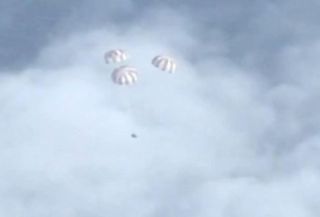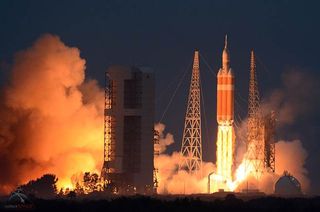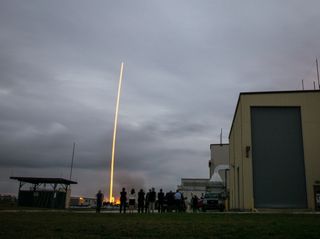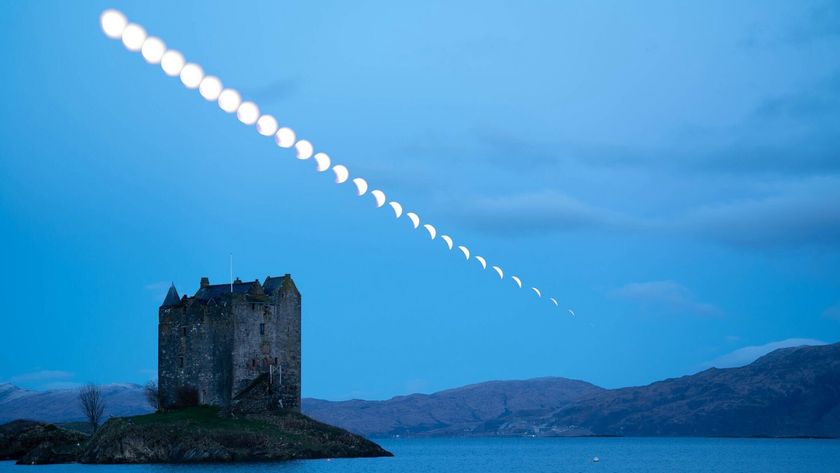Splashdown! NASA's Orion Spaceship Survives Epic Test Flight as New Era Begins

CAPE CANAVERAL, Fla. — NASA's new Orion spaceship, a capsule built to take humans farther into space than ever before, survived its first test flight Friday, splashing down in the Pacific Ocean to usher in a new era of deep-space exploration for the U.S. space agency.
The Orion space capsule — NASA's first capsule built for a trip to Mars — made a bull's-eye splashdown in the Pacific Ocean at 11:29 a.m. EST (1629 GMT) after a 4.5 hour uncrewed test flight. Orion's key systems were put to the test during the flight, which launched atop a United Launch Alliance Delta 4 Heavy rocket, from a pad here at Cape Canaveral Air Force Station at 7:05 a.m. EST (1205 GMT).
U.S. Navy officials are now fishing Orion out of the ocean, about 275 miles (442 kilometers) west of Baja California, before bringing it to port in San Diego, California. NASA wants to retrieve the capsule to use the valuable flight data recorded during the test. [See stunning photos from Orion's first test flight]
"Orion is back on Earth," NASA spokesman Rob Navias said during live commentary. "America has driven a golden spike as it crosses a bridge into the future."
A return to deep space


Today's flight, called Exploration Flight Test-1, marks the first time a spacecraft built for humans has traveled out of low-Earth orbit since Apollo 17 launched to the moon in 1972.
Orion seemed to function well during its first flight. NASA officials tested many of the major systems that could be needed for future crewed missions with the capsule. In total, 55 percent of the capsule's technology needed for a manned flight was tested Friday.
"It's tremendously exciting. It's so nice to see this happen and to see everything go so well," NASA astronaut Rex Walheim, who represented the astronaut corps during Orion's development, told Space.com. "We're going to learn so much from this flight … To see it [Orion] coming back in was just an absolute thrill."
Get the Space.com Newsletter
Breaking space news, the latest updates on rocket launches, skywatching events and more!
Orion's giant heat shield, the largest of its kind ever made, needed to withstand temperatures of up to 4,000 degrees Fahrenheit (2,200 degrees Celsius) when the craft hit Earth's atmosphere as the capsule was flying through space at about 20,000 mph (32,000 km/h). The spacecraft's parachute system also deployed well, slowing the capsule before splashdown in the Pacific Ocean.
A NASA drone flying above the Pacific during splashdown captured some amazing views of the capsule's red and white parachutes descending into the Ocean.
Just after launch, Orion successfully jettisoned its launch abort system — technology designed to propel the capsule and its future astronauts to a safe distance in case of a problem during launch.
At a little more than 3 hours after launch, the second stage of the Delta 4 Heavy rocket also propelled Orion to an altitude of slightly over 3,600 miles (5,793 kilometers), about 14 times farther than the orbit of the International Space Station.
NASA officials used the approximately 1,200 sensors aboard Orion to monitor the way the capsule's computers and other technology behave in the harsh space environment. Orion flew through belts of radiation twice during the flight (once on the way out, and again on the way back to Earth), allowing scientists to see how the spacecraft's computers behave in high-radiation.
Orion: NASA's new spaceship
Orion — built for NASA by Lockheed Martin — looks somewhat like the capsules flown during NASA's Apollo moon landing program, which took humans to the moon for the first time. The feeling on the ground is also somewhat reminiscent of launches during the space agency's shuttle era, the last time humans flew to space from U.S. soil.
"In the sense that we are beginning a new mission, it is, I think, consistent with … the beginning of [the space] shuttle [program], the beginning of Apollo," Mark Geyer, NASA's Orion program manager, said during a news conference before launch. "It's a new mission for us starting in the region of the moon and beyond. I think it's in that same category. Certainly the team is excited at that level. We're going to learn a lot on this flight."
About 27,000 spectators were expected to watch the launch on Thursday, its original launch date, from Kennedy Space Center's grounds, with thousands more expected to observe from the beaches and other viewing sites along Florida's Space Coast here, NASA officials said. Officials aren't yet sure how many viewers came back for the launch Friday.

This is the first flight for Orion, but it shouldn't be the last. NASA is planning on launching another uncrewed mission with the capsule sometime in 2017 or 2018.
That mission, dubbed Exploration Mission-1, will be the first flight of Orion with NASA's new mega rocket, the Space Launch System (SLS), currently in development. After that, Orion and SLS are expected to fly together again in 2021 for their first crewed mission.
The Orion capsule cannot deliver astronauts to Mars on its own. The spacecraft will need to be outfitted with a functional service module and a habitat module in order to make a trip to the Red Planet comfortable for the four astronauts on the journey, officials have said.
Editor's Note: This story is an updated version of an earlier story published after launch here - NASA Launches First Orion Deep-Space Capsule in Historic Test Flight
Follow Miriam Kramer @mirikramer. Follow us @Spacedotcom, Facebook and Google+. Original article on Space.com.
Join our Space Forums to keep talking space on the latest missions, night sky and more! And if you have a news tip, correction or comment, let us know at: community@space.com.

Miriam Kramer joined Space.com as a Staff Writer in December 2012. Since then, she has floated in weightlessness on a zero-gravity flight, felt the pull of 4-Gs in a trainer aircraft and watched rockets soar into space from Florida and Virginia. She also served as Space.com's lead space entertainment reporter, and enjoys all aspects of space news, astronomy and commercial spaceflight. Miriam has also presented space stories during live interviews with Fox News and other TV and radio outlets. She originally hails from Knoxville, Tennessee where she and her family would take trips to dark spots on the outskirts of town to watch meteor showers every year. She loves to travel and one day hopes to see the northern lights in person. Miriam is currently a space reporter with Axios, writing the Axios Space newsletter. You can follow Miriam on Twitter.









